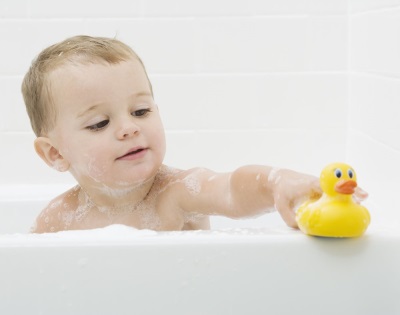How to put a child to sleep without tears and motion sickness?
If the mother is breastfeeding, then problems with laying down without tears usually do not occur until the moment of termination of breastfeeding. Usually parents of babies from 6 months to 2 years complain about the difficulties of laying. In this case, mothers may experience difficulties with laying down for the daytime sleep, and with evening bedtime, and waking up at night.
Laying a newborn with the help of motion sickness helps many parents in the first months, but when the little tot grows up and the mother discovers that the child is unable to fall asleep without the usual rocking, the problem of putting the baby to sleep without tears becomes very urgent. The child has become accustomed to falling asleep in this way, and mother often does not know how to put the baby differently - this is the root of this problem. What to do?
Schedule
Toddlers behave calmer when they live in a certain mode of the day. Newborns do not have such a regimen, as they do not distinguish between night and day, but already in the second month of life, the crumbs form their own wakefulness and sleep regime. By six months, the baby sleeps twice in the afternoon, and after a year - only once.
It is important that the baby goes to bed every day at the same time. If it is day, then after dinner, if it is evening, then after swimming and other procedures.
For children over 2 years of age, daily activity is important - if the baby stays at home all day and does not move much, he will be less tired and fall asleep more difficult for him.
Perseverance and patience
These are very important qualities for a mother who wants to teach her to fall asleep on her own and without motion sickness. If the mother decided to change the way of laying, then she should be consistent and not return to motion sickness. Starting to swing the baby again, she only confuses the crumbs.
Both parents must be confident and calm, and understand how important it is to establish a baby’s sleep, regularly observe evening procedures and pay attention to external elements (clothes, toys, bed and others). The baby will feel the psychological mood of mom and dad - if they are nervous and anxious, the child will be more difficult to tune in to rest.
Rituals
To facilitate the process of immersion of the baby in sleep helps "sleepy" ritual. These are certain actions in order, which is repeated every day for a long time. Such actions help the baby tune in to sleep. Among them may be:
- Bathing;
- Relaxing massage;
- Reading books and viewing pictures;
- Farewell to the sun and curtains curtain;
- Lullaby;
- Bedding toys;
- Saying certain phrases that are repeated daily.
When the baby gets used to such a ritual, it will sink into sleep without tears and whims. The only exception may be ailments, when the child has a fever or a tooth is cut, the ritual may not work and the mother will have to make additional efforts.
The duration of the ritual will be influenced by the temperament of the karapuz - calm babies can fall asleep after one or two actions, and for very active children a longer period of preparation for sleep is required.
Self sleep techniques
According to experts, the child should be taught to fall asleep on his own, just as he is taught to dress, eat or learn other skills.There are techniques that teach the baby to fall asleep on his own. They can be used from 9 months of age. Usually, all these techniques are aimed at eliminating the association of feeding and sleep, therefore, as a result of their use, food and sleep are separated in time, which makes it easier for the baby to fall asleep:
- With a timer. Before feeding, the child is introduced to the timer and it is said that when the bell rings, the milk will end. As soon as the timer emits a signal, the baby’s chest is taken away and the baby is placed in the crib. Mom needs to be patient and calm the baby, but do not give the breast anymore. In the first days on the timer set the time 10 minutes, then it is reduced to 4 minutes, and after weaning the breast, the mother reads the book to the child another 5-10 minutes. After a few days the laying is completely replaced by the reading of the book. So first affect the laying on naps, and then on the evening feeding.
- Gradually and gently weaning. Mom for a long period tries to lay the baby without sucking, but if the crumb asks for the breast, it does not refuse. Gradually, the mother manages to find other rituals to help the baby fall asleep, and as a result, the child stops drinking breast milk at night. The next step will be the abandonment of night feedings. If the child is more than 1.5 years old, he can be explained why there is no more breast milk.
- Using the exit from the room. This is a very painful way for the crumbs, but it may suit some tots. Mom, putting the baby in bed, leaves the room for 5 minutes, expecting the child to fall asleep. If the baby starts to cry, the mother returns, tries to calm the baby and leaves again. After a few days, the child begins to realize that he has no choice but to sleep on his own.

Tips
- Start weaning baby from motion sickness while laying recommended in the evening. Before a night's sleep, the child is determined to fall asleep more than during the day.
- If you are trying to lay your baby for quite a long time (an hour or more), make a short pause. Take a break and stop laying for 15-20 minutes, then return to the usual ritual (it can be shortened).
- It is not necessary to perceive the crying of the little one as a sign that you are making fun of the baby. The fact that the little one is protesting against the order he was used to is absolutely normal. You need to think about the future - soon the baby will stop crying, and your arms and back will no longer experience excessive strain.
- It is important not to miss the moment when the baby wanted to sleep. If you notice that the baby is yawning, has become sluggish, has begun to act up or is rubbing his eyes, then it’s time to go to bed.
- Do not forget that the conditions in the baby's room should be comfortable for sleeping (the temperature should be maintained at + 18 + 22 degrees, and the humidity should be 50-60%), and clothes for the child should be comfortable.
- Exclude an hour before laying any irritating and stimulating factors, for example, an active game or watching a cartoon. It is also important that the family atmosphere was friendly and calm.
- Let the baby fall asleep with toys if it calms him down. If the toy, with which the crumb constantly falls asleep, has worn out, it cannot be replaced with a new one. Just wash the “friend” and give it back to the child.
- If you put the baby to sleep in a separate bed, you can put a heating pad there for a short time before you put the baby in it.
How to put the child to sleep without a breast, see the video of Anna Gapchenko.











